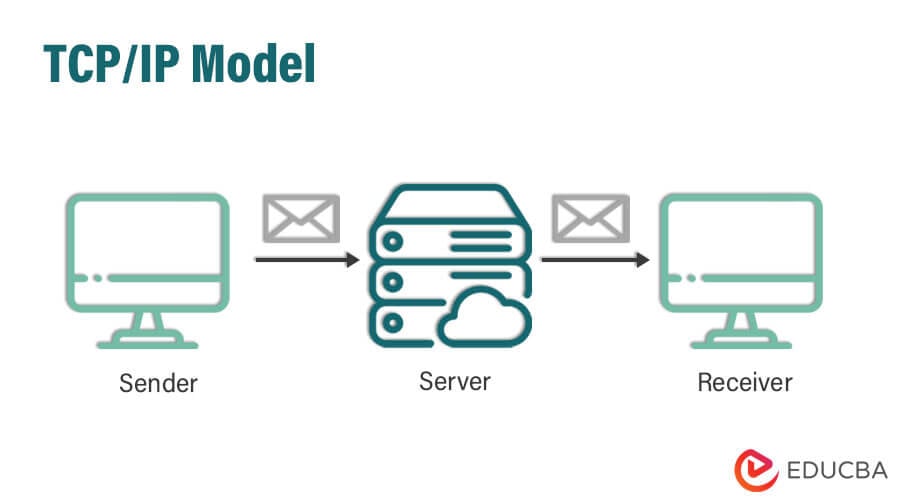Updated July 1, 2023

What is TCP/IP Model?
The following is a brief outline of TCP/IP Model. TCP/IP stands for Transmission Control Protocol/Internet Protocol. The model establishes all network communication between computers.
Understanding TCP/IP Model?
The United States Defense Department initially developed the Internet Protocol Suite during the 1970s. It connects heterogeneous systems and contains a popular set of communication protocols. TCP and IP are the most widely used protocols and differ from the OSI model.
How does TCP/IP work?
Below are a few points explaining the working of TCP/IP:
1. Network Access Layer
Here, the OSI model’s physical layer and data link layer combine to form the network access layer. It allows the transmission of data, physically, through the protocols and hardware elements of the layer. The availability of ARP is measured at layer 3 and summed up by layer 2 protocols.
2. Internet Layer
It functions similarly to the OSI network layer. All protocols for data transmission are as follows. The protocols are:
- IP: Stands for “Internet Protocol,” and it is in charge of packet distribution. This distribution is achieved between the source and the destination through the IP addresses in the packet headers. IPv4 and IPv6 are the most widely used versions. All current websites use IPv4, while IPv6 is largely growing in numbers.
- ICMP: Stands for “Internet Control Message Protocol.” All information regarding the network program is scripted here; it is measured to sum up with IP datagrams.
- ARP: Stands for “Address Resolution Protocol.” ARP determines the hardware address from the specified internet protocol address. The major classifications of ARP are: Reverse ARP, Gratuitous ARP, Proxy ARP, and Inverse ARP.
3. Host-to-Host Layer
It is much equivalent to the OSI model transport layer. All the complexities of data are shielded from the upper layers. The key protocols here are:
- Transmission Control Protocol (TCP): It is branded to supply steadfast and error-free communication among end systems. It is responsible for data segmentation and sequencing. TCP provides greater transparency, which leads to its higher cost.
- User Datagram Protocol (UDP): It is very cost-effective and can be used when security is not a major factor. UDP is a connectionless protocol.
4. Process Layer
All the functions of the top three layers of the OSI model, i.e., Application Layer, Session Layer, and Presentation layer, execute herein. It is responsible for controlling user interface specifications and node-to-node communication. The most commonly used protocols are: HTTP SNMP, NTP,NFS, HTTPS, FTP, TFTP, Telnet, SSH, SMTP, DNS, DHCP, NFS, X Window, and LPD.
- HTTP and HTTPS: Stand for Hypertext Transfer Protocol. These HTTP and HTTPS protocols manage server and browser communication. SSL and HTTP intermix herein. It is a systematic protocol for browser forms (sign in, validation, bank transactions).
- SSH: Stands for Secure Shell and is very much similar to Telnet. It is terminal emulation software. The primary reason for preferring SSH is its encrypted connection. Moreover, it is a highly secure network.
- NTP: Stands for Network Time Protocol. It harmonizes the clocks in the computer systems into a single standard time zone. NTP plays a crucial role in bank-oriented transactions.
Advantages of TCP/IP Model
Below are some advantages of the TCP/IP model:
- Deployable for network-oriented problems.
- The model allows communication between heterogeneous networks.
- It is an open network protocol suite, which makes it available to an individual or an institute.
- A scalable client-oriented architecture allows network additions without current services.
- For every system on the network, there is an IP value.
Scope of TCP/IP Model:
In the communication world, the base unit is packets. These packets are built using TCP/IP protocols. Every operating system has several sole ethics coded keen on its functioning of the TCP/IP stack. OS fingerprinting works on this basis, By swot up these exclusive ethics, values like MTU and MSS. It has been whispered previously to identify the irregular; there is a need first to recognize what is usual.
This acts as the need to recognize the normal TCP/IP packet looks and the procedure through which TCP/IP itself picks up communications between computers. By staring at genuine packets that are blubber off the wire through a packet imprison utility like tcpdump or the win32 alike windump. At the instance of double-clicking on the web browser, a syn packet has been sent out, and also, a syn/ack packet is returned to the user. Next, a set of ack packets are followed by psh/ack packets that allow exchanging data front and back.
Thus, TCP/IP is a powerful network communication protocol and program that allows access to remote terminals and computers through internet systems.
Recommended Articles
For related articles to the subject, please visit the following links:

